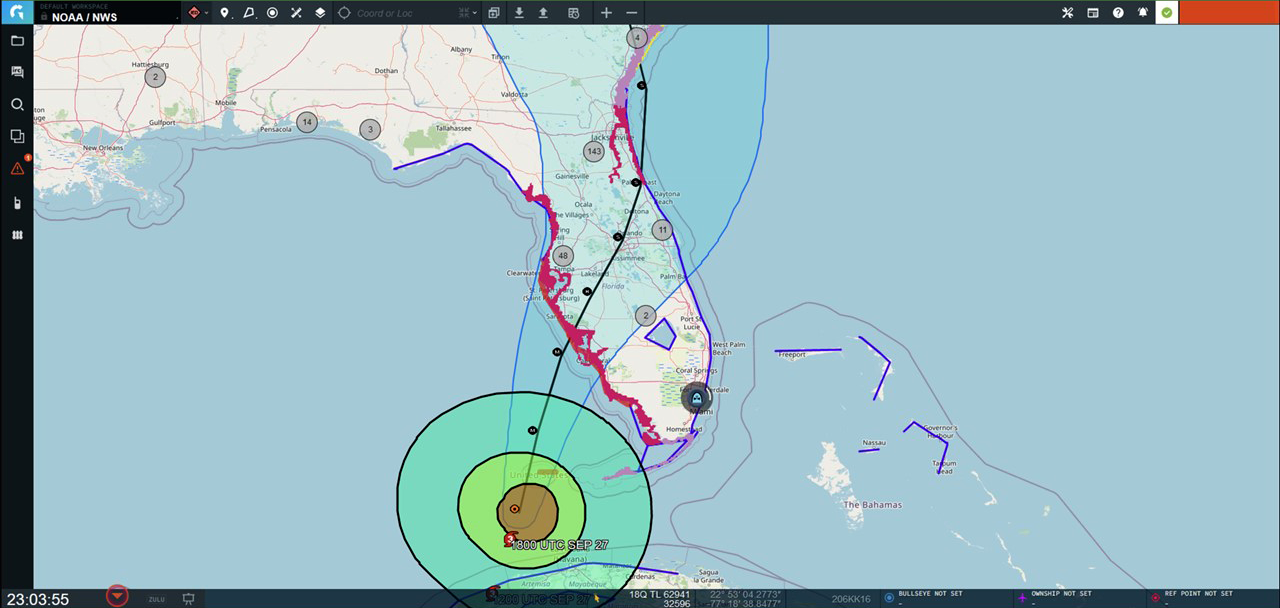AFRL Guardian software team reports busy year
ROME, N.Y. (AFRL) — When disaster strikes in the world, chaos can ensue, but Air Force Research Laboratory, or AFRL, scientists are working on software applications that provide clear situational awareness to help response teams bring calm to the chaos.
Guardian is one software application customized by AFRL’s Information Directorate that facilitates disaster response and battlefield efforts. Its primary function is to provide critical updates to command and control regarding deployed assets.
“Command and control are about decision superiority, and this software can improve security and protection during times of crisis or response,” said Col. Fred Garcia II, the director of AFRL’s Information Directorate. “It provides crucial information to the command team, enabling them to deploy resources and have better situational awareness of their teams during an operation.”
Guardian demonstrated its effectiveness during the 2022 California wildfires, providing complete situational awareness of various assets on the ground. As Hurricane Ian approached southeast U.S. in September 2022, an AFRL team saw a vital opportunity to put Guardian to the test and integrate Guardian software with disaster response efforts.
Working with TrailBlazer Innovations and the tracking and situational awareness team for U.S. Northern Command, or NORTHCOM, and National Guard Bureau, or NGB, units from multiple states, AFRL’s plan provided the Guardian software to assist in communication efforts on the ground.
“Disasters bring many disruptions to the landscape, similar to battlefield conditions,” said Todd Waskiewicz, AFRL Guardian project lead. “Often resources are in short supply, communications are little to nonexistent, and without precise coordination or direction, many resources can be lost in the situation Guardian gives leaders a better operational picture of what is available and where.”
Working with mission partners, the AFRL Guardian team provided a rapid capability update, meeting an urgent NGB request. In addition, the team, including developers from TBI and Aviture Inc., updated the application to display emergency location alerts in the Guardian software while ensuring a unified common operating picture.
“This alerting feature, paired with the mobile polling feature, allows leadership to poll areas and confirm personnel status,” Waskiewicz said. “For example, in heavily affected regions where personnel are known to be, leadership can survey that area, and all personnel will receive an alert asking them to respond on their phones if they are okay.”
During response operations to Hurricane Ian, NORTHCOM and NGB units deployed more than 400 satellite and terrestrial-based systems to track personnel locations, provide emergency alerts and communications, and give the command and general staff situational awareness on the ground using Guardian as a primary situational awareness tool.
National Guard units responding to the disaster had global situational awareness across the spectrum for Guard operations. The National Guard Bureau J31 operations team provided shared situational awareness and liaison synchronization between the NGB, National Guard Joint Force Headquarters-State and inter-organizational partners.
“Although similar in concept to some commercial applications denoting status in emergency events, Guardian has some critical differences in its ability to provide an intelligent response and two-way communications that provide real-time status updates that give the command staff an accurate picture of deployed assets,” Waskiewicz said.
Guardian pulls data from multiple streaming sources and provides users with one display for planning, operations and intelligence information.
“These features allow for more effective accountability and precise situational awareness in response to disasters or on the battlefield,” Waskiewicz added.
Brian O’Hern, program manager and senior electronics engineer at AFRL’s Information Directorate, started Guardian in 2009. The tool was initially called Syracuse Intelligence Reconnaissance Information System. When Open Architecture Distributed Common Ground System, an Air Force open architecture system for fielding modular upgrades and updates on standardized infrastructure, adopted it, the software was renamed Guardian.
In 2010, the New York National Guard MQ-9 squadron employed Guardian in remote-piloted aircraft combat operations. Air Combat Command, Air Force Special Operations Command and the Air National Guard later selected the software as part of the remote-piloted aircraft squadron operations center baseline in 2011.
“Guardian adds to a broad selection of AFRL crossover technologies that have practical applications in the high-growth disaster response and readiness sector and is an additional AFRL tool that provides a complete common operating picture for teams in the field,” said Waskiewicz.

As Hurricane Ian approaches the southeast United States, Sept. 23, 2022, the National Weather Service provides path updates with potential trajectories. Grey circles highlight assets identified by Guardian, a software application customized by the Air Force Research Laboratory that facilitated disaster response efforts with real-time command and control situational awareness. (U.S. Air Force graphic / Todd Waskiewicz)
